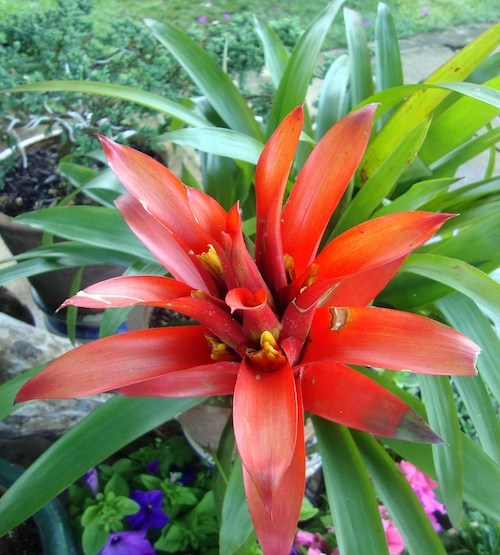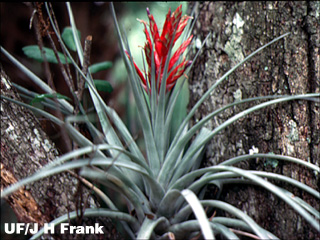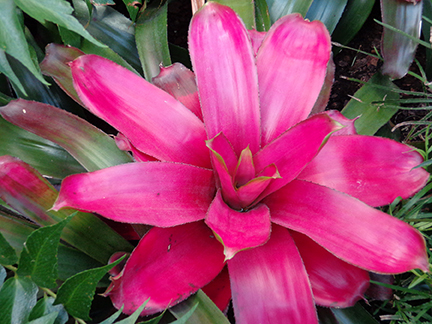Bromeliads: Beautiful Additions to Your Indoor Garden
By Carolyn Casey, Fairfax Master Gardener
Bromeliads are very interesting, unique and beautiful plants. Their foliage ranges from very colorful bracts to silvery-gray scales. Also, they can either be terrestrial or epiphytic. Did you know that terrestrial bromeliads need soil to grow while epiphytic bromeliads do not live in soil but cling to trees and other support structures like rocks? Native to Central and South America, they are tropical or subtropical plants. Bromeliads are from the Bromeliaceae family. There are thousands of bromeliads that come in many shapes and sizes, from 1 inch (2 cm) to 35 feet (10 m) tall. Many do not have common names, but instead they are known by their genus. Well-known members of the bromeliad family are pineapples and Spanish moss.
Terrestrial Bromeliads

Guzmania bromeliad
Terrestrial bromeliads are usually grown as houseplants in our Zone 7 climate. They are broadleaf evergreens with an erect growth habit that require medium maintenance and are easy to grow. The main thing to consider when choosing a bromeliad is the amount of light your home receives. The amount of light can affect a bromeliad’s leaf color, leaf shape and growth rate. Light levels that are too low will lead to leaves that are long, thin, drooping and greener in color. Levels that are too high will make leaves grow shorter, thicker and pale green or yellow in color. Indirect light is best for bromeliads and helps them produce flowers.
Guzmanias are well-known terrestrial bromeliads. They are herbaceous houseplants with beautiful showy bracts of bright red, orange, pink and green that range in size from 3 to 6 inches (7 to 16 cm), with small white and yellow flowers that bloom in the summer. Their bracts are in a torch shape, and the flowers form rows in the center. The leaves have an overlapping rosette shape forming a funnel that looks like a vase. The funnel-shaped rosettes are called tanks that hold water and should be kept filled. Do not soak the soil as you fill the tank since bromeliads are prone to root rot. Flush the tank periodically by pouring fresh water into it then inverting and filling with water again. This prevents stagnation and the buildup of mineral salts.
Terrestrial bromeliads grow 2 to 4 feet tall (60 to 120 cm) and 1 to 2 feet wide (30 to 60 cm). They are slow-growing and long-lived. Did you know that some people cut the bracts and use them in floral arrangements? They have limited root systems that serve mainly as anchors for the plant. It is best to provide them with a loose, well-drained potting soil. They like temperatures of 70 degrees (21 C) during the day and 55 to 60 (12 to 15 C) degrees at night.
In Zone 7, terrestrial bromeliads can be grown outdoors in containers during the summer months but need to be brought indoors before the frost. Cold-hardy bromeliads are those in the genus Puya. They are native to the Andes where they grow in desert conditions and even snow. They survive in temperatures down to 20 degrees (-6 C). They need to be well-watered and their soil needs to dry out between waterings. If you’re growing bromeliads outdoors, you should flush the tanks that collect water at the base of the leaf rosettes because these can be breeding grounds for mosquitoes.
Epiphytic Bromeliads

Tillandsia fasciculata bromeliad
Tillandsias are the largest group of epiphytic bromeliads, also known as air plants, and most do not have tanks. This genus has close to 500 species and is the largest, most diverse and widely distributed genus in the bromeliad family. Did you know that the word epiphytic means ‘upon plants’ and refers to plants that use other plants for physical support? Epiphytic bromeliads do not live in soil. They grow on other plants and contrary to what some people believe, epiphytic bromeliads are not parasites. They do not harm their host plant but use trees and shrubs for support. They get their energy the same way other plants do by photosynthesis. They are twisted wiry plants with leaves that are covered with silver grey scales. They can be mounted on driftwood for support and need bright filtered sunlight. They bloom with pink flower stalks and blue, purple, red, orange or white flowers.
Epiphytic bromeliads need very little water at their base but moisture is important. They absorb water and nutrients mainly through their leaves and through the cups at the base of their leaves. They obtain all of the water and minerals that they need from their environment. These plants can be completely immersed in room temperature water for about a half hour every week to ten days. They need humidity to grow, and most homes don’t have enough moisture, so you must provide humidity for your plants by misting them every two to three days. A good place to grow your plant is in the kitchen or bathroom window where there will be humidity from washing dishes or taking showers helping to supply them with water. This is very important for air plants since they obtain moisture from the air. Try not to handle the plants to prevent rubbing off the scales since the silver grey scales that cover the plant absorb moisture and nutrients that are necessary for the plants’ survival.

Aechmea fasciata bromeliad
Other Popular Types of Bromeliads
Aechmea bromeliads are known as urn plants due to their upright vase-looking shape. These plants are easy to care for and are consistent bloomers. They have leaves with spiny edges and come in a variety of colors. They can be speckled and can have bands of silver scales. The beautiful flower spikes on the urn plant can last from a few weeks to six months. It is best to attach these plants to a piece of wood or other material when they are young. They like bright light and warm temperatures and having their tanks filled. Make sure that their soil dries out between waterings and lightly fertilize them in the summer.
Ananas bromeliads are ornamental pineapples and commercially grown pineapple plants. They are large plants with large leaves that can be 3 to 5 feet (1 to 1.5 m) long. They like strong light, rich soil, regular fertilization and moisture. They have spiny leaves that form a rosette where the flower forms and produces a pinecone-shaped fruit. It is possible to propagate pineapples from the pups at the base of the plant by planting the topknot of the fruit.

Neoregelia bromeliad
Neoregelia bromeliads, known as blushing bromeliads or fingernail plants, have stunning foliage with green, bronze, yellow, orange, red, purple, pink and white leaves. These colors often change (blush) when they start to bloom. These plants are the most widely hybridized bromeliads. They like being grown in small pots, with little fertilizer, dry soil and strong light. Too much fertilizer and too little light causes the leaves to turn green. Remember to keep water in their tank.
Vrieseas bromeliads are mostly tank epiphytes that have rosettes that form broad vases. They have shallow root systems that need to be kept fairly dry. They have cultural needs similar to Guzmanias, needing moderate light, warm temperatures and moist air. Use a dilute fertilizer and feed them through their leaves. They have smooth-margined leaves that can be shiny green or have patterns of scales or translucent windows. The beautiful inflorescences are mainly flat and create a sword-shaped appearance. They can be either single or branched. They have brightly colored red, yellow and bicolor bracts that overlap and last for months. There is a soft green leaf variety, whose hybrids need more moisture and shade. There are also plants with banded or silvery leaves that need less water and more light.
Cryptanthus bromeliads are known as earth stars. They look like brightly colored starfish, and they rest almost flat on the ground. Their leaves are green, brown, bronze, silver, white or red, and they can be solid, striped and banded. They are terrestrial bromeliads and unlike epiphytic bromeliads, they cannot be mounted but need to be planted in rich organic soil. The soil must dry out a little between waterings, and they need to be fertilized every month from the mid-spring and into the early fall. They prefer bright diffused light, and their small size makes these plants perfect for dish gardens.
General Information
All bromeliads need to be fertilized by spraying the leaves one to two times a year in the spring or summer with orchid fertilizer at ½ the recommended strength. Do not put fertilizer in the tank because fertilizer salts may burn the new leaves. Water bromeliads with distilled water, rainwater or filtered water since chemicals in unfiltered tap water may harm your plant causing slow growth and brown leaf tips. Trapped plant materials are decomposed by bacteria and fungi and absorbed by the trichomes lining the bromeliad tanks. Among these plant materials are dead and drowning non-aquatic insects, which also provide nutrients for the bromeliads. Catopsis berteroniana, a species of tank bromeliad found in south Florida that traps insects and uses their nutrients, is considered a carnivorous plant.
All bromeliads bloom only once and then the mother plant will die and offsets known as pups will appear at the base of your plant. Remove the pups when they are 1/2 the size of the mother plant by cutting the pup off where it attaches to the mother plant and putting it in a potting mix. It takes a year for the pup to mature, and bromeliad plants must be mature for them to flower. Scale and mealy bugs can sometimes be a problem for your bromeliad.
You can force a bromeliad to bloom by first draining all of the water off the plant and placing it in a clear plastic bag that does not have any holes in it with an apple inside. Apples produce ethylene as they ripen, and this promotes the formation of flowers on bromeliads. Keep the plant in the bag with the apple for seven to ten days. During this time do not place it near excessive light. Then remove the plant, replace the water and put it in its usual location. Depending on the species, it should bloom in about six weeks.
I hope that you enjoy the beauty and uniqueness of bromeliads in your home! Happy gardening!
References
• Guzmania, Gardener Plant Toolbox, North Carolina State Extension
• Bromeliads, Gardening Solutions, University of Florida
• Bromeliads, HGIC 1501, Mark Arena, Clemson Cooperative Extension, Home and Garden
Information Center
• Bromeliads, HGIC 1305, Planttalk Colorado, Colorado State University Extension
• Bromeliads: Houseplants That Endure, David Trinklein, Integrated Pest Management, University
of Missouri
• Florida’s Native Bromeliads, Barbra C. Larson, J. Howard Frank, Martin B. Main, and Ginger M. Allen,
University of Florida Extension
• Bromeliads, Susan Mahr, University of Wisconsin — Madison Extension
… updated 2023